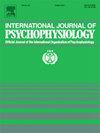眼睛盯着奖品:眼球追踪证据表明注意力偏向赌博和自然奖励
IF 2.6
3区 心理学
Q3 NEUROSCIENCES
引用次数: 0
摘要
本研究调查了赌徒和非赌徒的注意偏差(ABs),重点研究了赌博相关和食物相关的刺激,以检验这些偏差与成瘾的激励敏感化(IS)和奖励缺乏综合征(RDS)模型之间的关系。使用眼动追踪方法,我们评估了ab在涉及两种类型图像的三种情况下的差异:食物vs.赌博,食物vs.中性,赌博vs.中性。与中性线索相比,赌徒对赌博相关刺激表现出显著的AB,支持IS模型。然而,当赌博和食物图像进行比较时,没有发现AB的显著差异,部分地否定了赌徒对赌博刺激表现出更强的偏见的假设。相比之下,非赌徒对与食物相关的图像表现出明显的偏好,正如IS模型所预测的那样。此外,群体差异表明,赌徒比非赌徒更关注与赌博有关的线索。然而,与中性图片相比,食物图片引起的赌徒和非赌徒的注意力水平相似,而不是与赌博有关的图片。这些发现强调了ABs在赌博行为发展和维持中的作用,支持IS模型,但不支持RDS模型。本研究还探讨了AB与赌博严重程度及赌博障碍中其他相关心理因素的关系,为赌博成瘾的认知机制提供了新的见解。这些结果表明,ABs可以作为干预的目标,旨在改变注意力模式和减少赌博相关的渴望。本文章由计算机程序翻译,如有差异,请以英文原文为准。
Eyes on the prize: Eye-tracking evidence of attentional biases toward gambling and natural rewards
The present study investigates attentional biases (ABs) in gamblers and non-gamblers, focusing on both gambling-related and food-related stimuli to examine the relationship between these biases and the Incentive Sensitization (IS) and Reward Deficiency Syndrome (RDS) models of addiction. Using an eye-tracking methodology, we assess how ABs differ across three conditions involving two types of images: Food vs. Gambling, Food vs. Neutral, and Gambling vs. Neutral. Gamblers showed a significant AB toward gambling-related stimuli compared to neutral cues, supporting the IS model. However, when gambling and food images were compared, no significant difference in AB was found, partially disconfirming the hypothesis that gamblers exhibit a stronger bias toward gambling stimuli. In contrast, non-gamblers demonstrated a clear preference for food-related images, as predicted by the IS model. Additionally, group differences revealed that gamblers allocated more attention to gambling-related cues than non-gamblers. However, food images elicited similar levels of attention from both gamblers and non-gamblers when compared to neutral images, rather than gambling-related images. These findings highlight the role of ABs in the development and maintenance of gambling behaviour, supporting the IS model but not the RDS model. The study also explores the association between AB and severity of gambling and other relevant psychological factors in gambling disorder, providing new insights into the cognitive mechanisms underlying gambling addiction. These results suggest that ABs could be targeted in interventions aimed at modifying attention patterns and reducing gambling-related cravings.
求助全文
通过发布文献求助,成功后即可免费获取论文全文。
去求助
来源期刊
CiteScore
5.40
自引率
10.00%
发文量
177
审稿时长
3-8 weeks
期刊介绍:
The International Journal of Psychophysiology is the official journal of the International Organization of Psychophysiology, and provides a respected forum for the publication of high quality original contributions on all aspects of psychophysiology. The journal is interdisciplinary and aims to integrate the neurosciences and behavioral sciences. Empirical, theoretical, and review articles are encouraged in the following areas:
• Cerebral psychophysiology: including functional brain mapping and neuroimaging with Event-Related Potentials (ERPs), Positron Emission Tomography (PET), Functional Magnetic Resonance Imaging (fMRI) and Electroencephalographic studies.
• Autonomic functions: including bilateral electrodermal activity, pupillometry and blood volume changes.
• Cardiovascular Psychophysiology:including studies of blood pressure, cardiac functioning and respiration.
• Somatic psychophysiology: including muscle activity, eye movements and eye blinks.

 求助内容:
求助内容: 应助结果提醒方式:
应助结果提醒方式:


